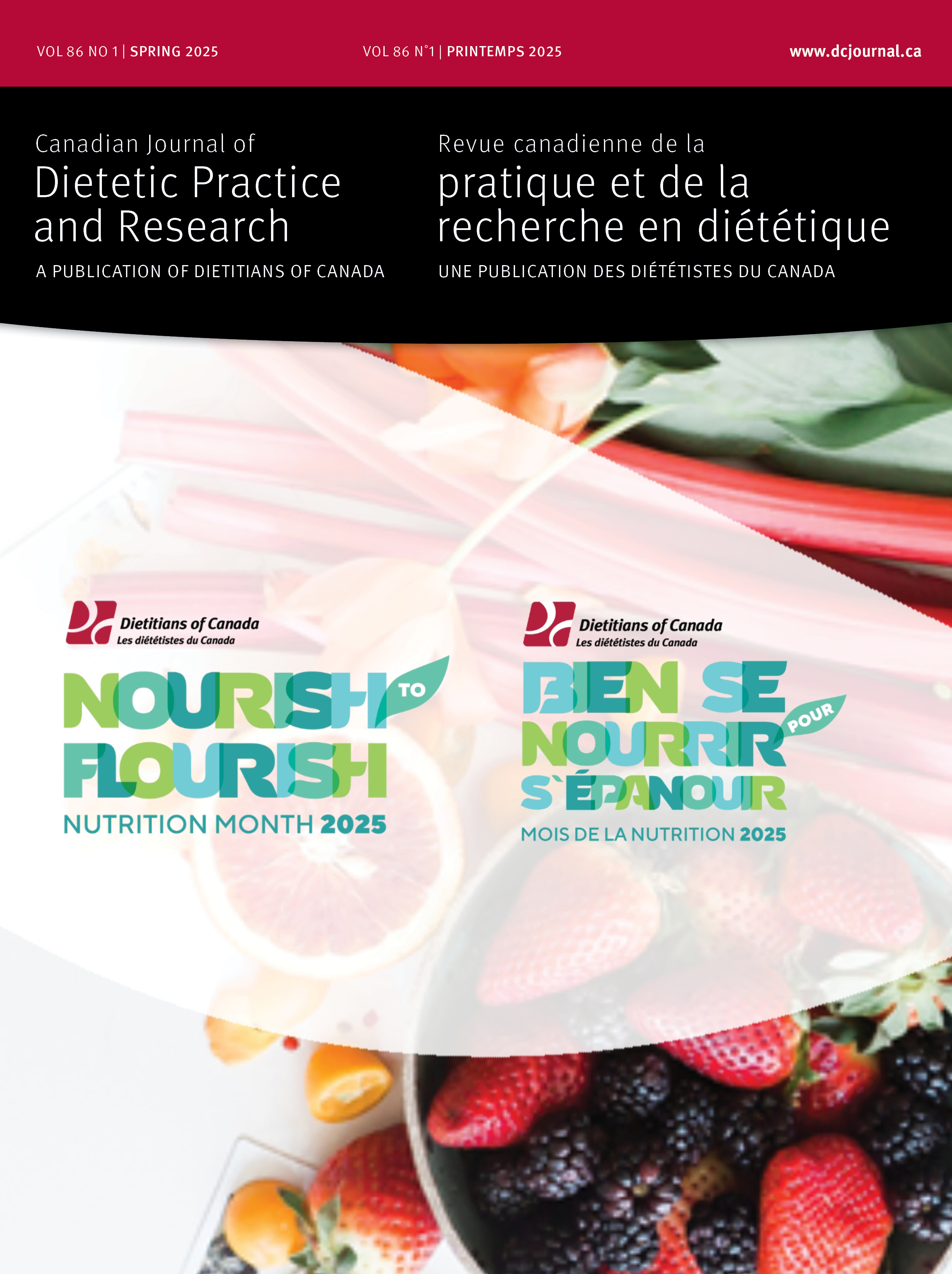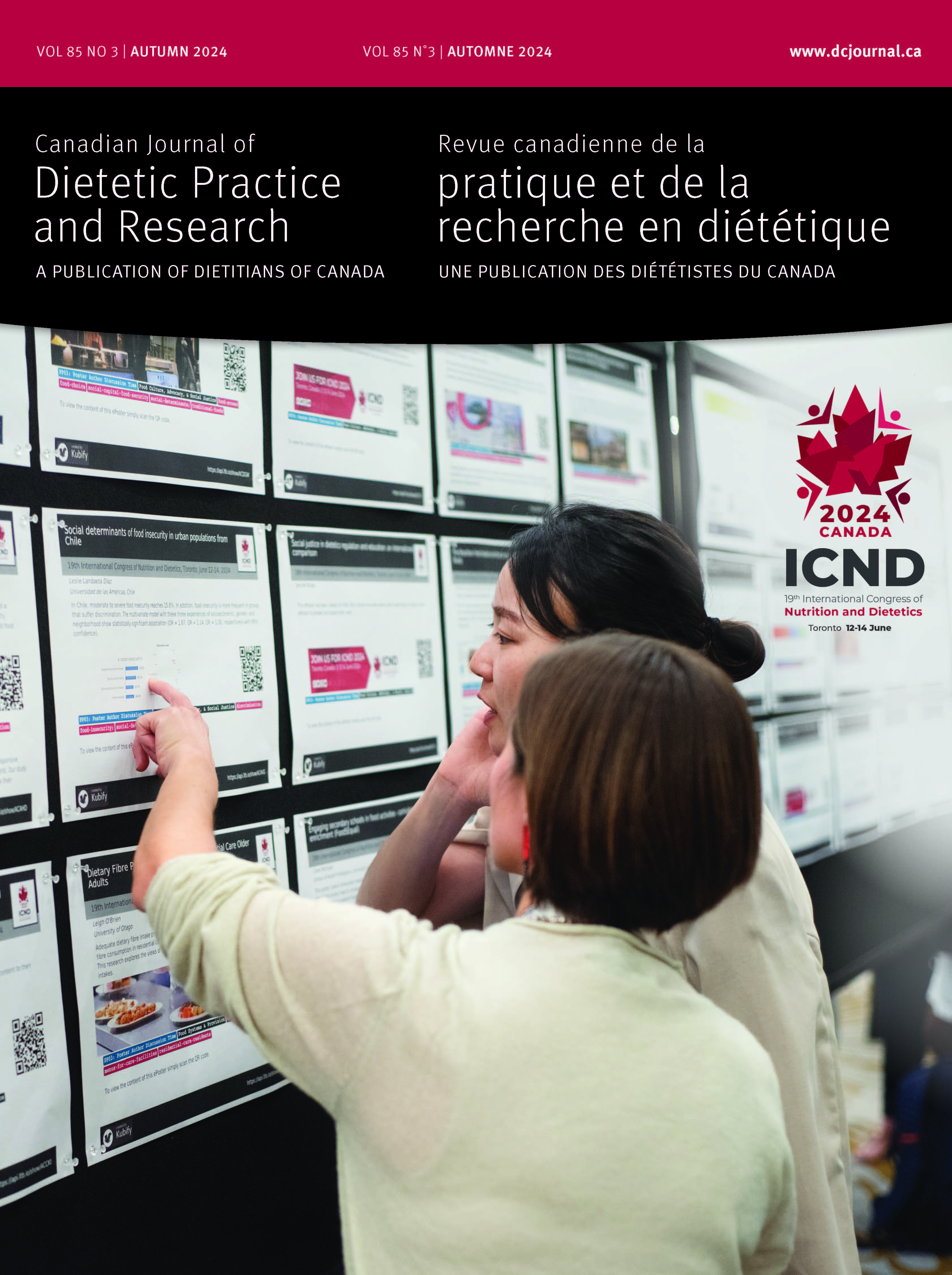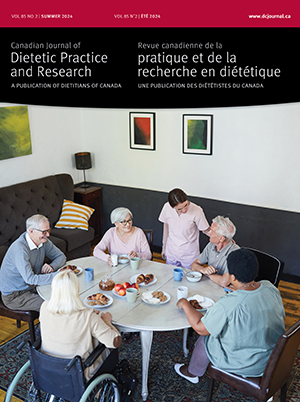Volume 79 • Number 2 • June 2018
Editor's Message
Research
Purpose: Patient satisfaction with hospital food enhances consumption and adequate intake of nutrients required for recovery from illness/injury and maintenance of health; accordingly, the nutrient content of the menu must balance patient preferences. This study of Ontario hospital foodservice departments collected data on current practices of analyzing the nutritional adequacy and assessing patient satisfaction with menus, and it explored perceptions of priority issues.Methods: Foodservice managers/directors from 57 of 140 (41%) hospitals responded to cross-sectional in-depth telephone interviews. Deductive analysis of responses to open-ended questions supplemented quantitative data from closed-ended questions.Results: The hospitals without long-term care facilities (LTCFs) assessed regular (58%), therapeutic (53%), and texture-modified (47%) menus for nutritional adequacy. This differed from hospitals governing LTCFs where there was a higher frequency of assessment of regular (75%), therapeutic (75%), and textured-modified (66%) menus. Most departments (86%–94%) obtained patient satisfaction feedback at the departmental/corporate levels. Many identified budget and labour issues as priorities rather than assessing menus for nutritional adequacy and patient satisfaction.Conclusions: Hospital menus were not consistently assessed for nutritional adequacy and patient satisfaction; common assessment methodologies and standards were absent. Compliance standards seem to increase the frequency of menu assessment as demonstrated by hospitals governing LTCFs.
Purpose: In Canada, dietitians serve a sex-diverse population despite the profession being predominately female (>95%). It is unknown why there are so few male dietitians. The objective of the present study was to explore the experience of the male dietitian, as a minority, in female-dominated dietetics.Methods: Two semi-structured interviews were conducted, approximately 6 weeks apart, with Nova Scotian male dietitians. The interviews prompted participants to reflect on their experience of being a male dietitian. Interviews were analyzed using Interpretative Phenomenological Analysis.Results: Male dietitians with between 1 and 17 years of experience participated (n = 6). Participant experiences were expressed as 4 themes: (i) feelings of difference and otherness, (ii) adapting to the female-dominated culture, (iii) constructing a professional identity, and (iv) passion as the driver for success. A theoretical framework for understanding the male dietitian’s experience was outlined.Conclusion: The experience of the male dietitian is unique and is a consequence of training and practicing in a female-dominated space. The effect of adaptation and construction of a professional identity that is a response to female-dominated cultural norms is wide ranging and may be constraining for male practitioners thereby affecting their contributions to the field.
Purpose: This paper aims to: (i) visualize the networks of food insecurity policy actors in Canada, (ii) identify potential food insecurity policy entrepreneurs (i.e., individuals with voice, connections, and persistence) within these networks, and (iii) examine the political landscape for action on food insecurity as revealed by social network analysis.Methods: A survey was administered to 93 Canadian food insecurity policy actors. They were each asked to nominate 3 individuals whom they believed to be policy entrepreneurs. Ego-centred social network maps (sociograms) were generated based on data on nominees and nominators.Results: Seventy-two percent of the actors completed the survey; 117 unique nominations ensued. Eleven actors obtained 3 or more nominations and thus were considered policy entrepreneurs. The majority of actors nominated actors from the same province (71.5%) and with a similar approach to theirs to addressing food insecurity (54.8%). Most nominees worked in research, charitable, and other nongovernmental organizations.Conclusions: Networks of Canadian food insecurity policy actors exist but are limited in scope and reach, with a paucity of policy entrepreneurs from political, private, or governmental jurisdictions. The networks are divided between food-based solution actors and income-based solution actors, which might impede collaboration among those with differing approaches to addressing food insecurity.
Purpose: To conduct a qualitative evaluation of adjunct supports (brief motivational messaging regarding goals delivered by email/website, contact centre dietitian assistance) offered by EatRight Ontario (ERO) for users of a website-based nutrition/activity goal setting/tracking feature (eaTracker “My Goals”).Methods: One-on-one semi-structured interviews were conducted with My Goals users in Ontario (n = 18) and Alberta (n = 5) recruited via the eaTracker website and ERO contact centre dietitians (n = 5). Interview transcripts were analyzed using content analysis.Results: Participants had mixed experiences and perspectives with ERO motivational messaging. Messages targeted towards specific goals (e.g., tips, recipes) were generally well-liked, and generic messages (e.g., eaTracker login reminders) were less useful. No interviewed users had contacted ERO dietitians regarding goals, and dietitians reported encountering few callers asking for assistance while using My Goals. Limited user knowledge was one explanation for this finding. Participants provided suggestions to enhance these supports.Conclusion: Electronic motivational messaging and contact centre dietitian assistance have the potential to support achievement of goals set with website-based features. When considering using electronic messaging, researchers and practitioners should consider message content and delivery tailoring. Marketing that focuses on how contact centre dietitians can assist website users with their goals is needed when services are used in naturalistic settings.
Perspecitves in Practice
Transgender people are an important group for whom access to healthcare is often problematic. Dietitians need to be aware of key issues in transgender health to provide culturally competent clinical nutritional care. This article serves as a primer, clarifying key terms and concepts, exploring the impact of stigma and discrimination on health and nutrition for people from transgender communities, and offering practical advice for nutritional and other related issues. Education for dietitians both pre- and postqualification is an important part of improving care and building skills and awareness of cultural humility. Transgender people may be at increased nutritional risk due to increased risk of cardiovascular disease, HIV, body image issues, and food insecurity. This risk profile, along with the history of trauma both outside and related to the medical community means that there is an urgent need for dietitians to develop practice tools for assessment, care, and referral to improve the nutritional status and well-being of this client group.
Lesbian, gay, bisexual, trans, and queer people (LGBTQ) have unique concerns regarding their nutritional health while experiencing disparities within the Canadian healthcare system. Dietetic training programs often do not provide adequate knowledge or skills to students to be competent in meeting the needs of this population. Drawing from literature from other health programs, this paper outlines key strategies to the integration of LGBTQ curriculum into dietetic training programs. LGBTQ training can help students gain cultural competencies, knowledge and understanding of the LGBTQ communities, and the nutritional concerns within them.
Report
Purpose: The Guelph Family Health Study (GFHS) pilot was designed to examine the feasibility and effectiveness of a home-based obesity prevention intervention on health behaviours and obesity risk. The objective of this analysis was to determine the effect of the 6-month intervention on preschool-aged children’s dietary intakes.Methods: Families with children aged 1.5–5 years old were randomized to receive one of the following: 4 home visits with a health educator as well as tailored emails and mailed incentives (4HV; n = 19 children); 2 home visits with a health educator as well as tailored emails and mailed incentives (2HV; n = 14 children); or general health advice through emails (control; n = 12 children). Three-day food records were completed by parents for their children before and after the 6-month intervention and analyzed for 3-day average intakes of energy, nutrients, and MyPlate food groups.Results: After the 6-month intervention, the 4HV group had significantly higher fibre intake and the 4HV and 2HV groups had significantly higher fruit intake, both compared with the control group.Conclusions: This study provides support for a home-based intervention approach to improve the diet quality of preschool-aged children.










